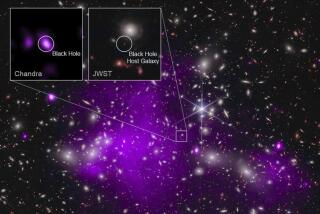Hubble spots spiral galaxy that shouldn’t exist
- Share via
Astronomers using the Hubble Space Telescope have discovered the oldest known spiral galaxy, a 10.7-billion-year-old anomaly that by all rights shouldn’t exist. The galaxy was present in the early universe, about 3 billion years after the Big Bang, at a time when galaxies were still forming and normally looked clumpy and irregular. “The vast majority of old galaxies look like train wrecks,” said UCLA astronomer Alice E. Shapley, one of the discoverers of the unusual spiral galaxy. “Our first thought was, why is this one so different, and so beautiful?”
A team headed by astronomer David R. Law of the University of Toronto, a former graduate student at UCLA, used the Hubble to observe more than 300 distant galaxies and study their properties. One of the galaxies, named BX442, appeared unusual, and the team used the W. M. Keck Observatory in Hawaii to study it further. At first, the astronomers thought that it was an illusion of a spiral galaxy caused by the accidental alignment of two galaxies in the images. But studies of spectra from more than 3,600 locations in and around the galaxy revealed that it is, indeed, a rotating spiral galaxy, they reported in the journal Nature.
In fact, it is a so-called grand design spiral galaxy, which has prominent, well-formed spiral arms. “The fact that this galaxy exists is astounding,” Law said. “Current wisdom holds that such grand design spiral galaxies didn’t exist at such an early time in the history of the universe.”
The reason this one does exist may be the companion dwarf galaxy that appears to be merging with it. Computer simulations by co-author Charlotte Christensen of the University of Arizona suggest that such a merger could produce the spiral pattern observed. The calculations also suggest, however, that the merger would be rapid and that the spiral would disappear after a relatively brief 100 million years. Apparently, astronomers just happen to be looking at BX442 at the right time.
LATimesScience@gmail.com
Twitter/@LATMaugh




